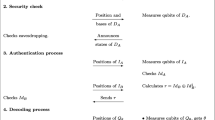Abstract
Recently, Yu et al. [Int. J. Theor. Phys., 2012, doi:10.1007/s10773-012-1336-y] proposed a quantum secure direct communication (QSDC) with authentication using two non-orthogonal states. This study points out a pitfall in Yu et al.’s scheme, in which an eavesdropper can deliberately modify the message without being detected. Furthermore, an enhanced scheme is proposed to avoid the modification attack.
Similar content being viewed by others
References
Lee, H., Lim, J., Yang, H.: Quantum direct communication with authentication. Phys. Rev. A 73(4) (2006)
Zhang, Z.J., Liu, J., Wang, D., Shi, S.H.: Comment on “Quantum direct communication with authentication”. Phys. Rev. A 75(2) (2007)
Liu, W.J., Chen, H.W., Li, Z.Q., Liu, Z.H.: Efficient quantum secure direct communication with authentication. Chinese Phys. Lett. 25(7), 2354–2357 (2008)
Qin, S.J., Wen, Q.Y., Meng, L.M., Zhu, F.C.: High efficiency of two efficient QSDC with authentication is at the cost of their security. Chin. Phys. Lett. 26(2) (2009)
Yen, C.A., Horng, S.J., Goan, H.S., Kao, T.W., Chou, Y.H.: Quantum direct communication with mutual authentication. Quantum Inf Comput 9(5–6), 376–394 (2009)
Liu, D., Pei, C.X., Quan, D.X., Zhao, N.: A new quantum secure direct communication scheme with authentication. Chin. Phys. Lett. 27(5) (2010)
Yang, J., Wang, C.A., Zhang, R.: Quantum secure direct communication with authentication expansion using single photons. Commun. Theor. Phys 54(5), 829–834 (2010)
Sun, Z.W., Du, R.G., Long, D.Y.: Quantum secure direct communication with quantum identification. Int. J. Quant. Inf. 10(1) (2012)
Tsai, C.W., Wei, T.S., Hwang, T.: One-way quantum authenticated secure communication using rotation operation. Commun. Theor. Phys 56(6), 1023–1026 (2011)
Yu, C.-H., Guo, G.-D., Lin, S.: Quantum secure direct communication with authentication using two nonorthogonal states. Int. J. Throe. Phys. (2012). doi:10.1007/s10773-012-1336-y
Cai, Q.-Y.: The “ping-pong” protocol can be attacked without eavesdropping. Phys. Rev. Lett. 91(10), 109801(1) (2003)
Yang, C.-W., Hwang, T.: Improved QSDC protocol over a collective-dephasing noise channel. Int. J. Throe. Phys. 51(12), 3941–3950 (2012)
Damgard, I.B.: A design principle for hash functions. In: Advances in Cryptology (Crypto 89), vol. 435, pp. 416–427 (1990)
Deng, F.G., Zhou, P., Li, X.H., Li, C.Y., Zhou, H.Y.: Robustness of two-way quantum communication protocols against Trojan horse attack. Q. Phys. (2005). arXiv:quant-ph/0508168v1
Cai, Q.Y.: Eavesdropping on the two-way quantum communication protocols with invisible photons. Phys. Lett. A 351(1–2), 23–25 (2006)
Deng, F.G., Li, X.H., Zhou, H.Y., Zhang, Z.J.: Improving the security of multiparty quantum secret sharing against Trojan horse attack. Phys. Rev. A 72(4), 044302 (2005)
Deng, F.G., Li, X.H., Zhou, H.Y., Zhang, Z.J.: Improving the security of multiparty quantum secret sharing against Trojan horse attack (vol. 72, art. No. 044302, 2005). Phys. Rev. A 73(4), 049901 (2006)
Li, X.H., Deng, F.G., Zhou, H.Y.: Improving the security of secure direct communication based on the secret transmitting order of particles. Phys. Rev. A 74(5), 054302 (2006)
Yang, C.-W., Hwang, T., Luo, Y.-P.: Enhancement on “Quantum Blind Signature Based on Two-State Vector Formalism”. Q. Inf. Process. 12(1), 109–117 (2013)
Acknowledgements
This research is supported by the National Science Council, Taiwan, R.O.C., under the Contract No. NSC 100-2221-E-006-152-MY3.
Author information
Authors and Affiliations
Corresponding author
Rights and permissions
About this article
Cite this article
Yang, CW., Hwang, T. & Lin, TH. Modification Attack on QSDC with Authentication and the Improvement. Int J Theor Phys 52, 2230–2234 (2013). https://doi.org/10.1007/s10773-013-1498-2
Received:
Accepted:
Published:
Issue Date:
DOI: https://doi.org/10.1007/s10773-013-1498-2




